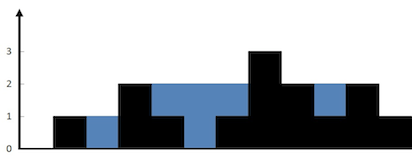题目描述
给定 n 个非负整数表示每个宽度为 1 的柱子的高度图,计算按此排列的柱子,下雨之后能接多少雨水。
示例1:

输入:height = [0,1,0,2,1,0,1,3,2,1,2,1]
输出:6
解释:上面是由数组 [0,1,0,2,1,0,1,3,2,1,2,1] 表示的高度图,在这种情况下,可以接 6 个单位的雨水(蓝色部分表示雨水)。
示例2:
输入:height = [4,2,0,3,2,5]
输出:9
提示:
n == height.length0 <= n <= 3 * 1040 <= height[i] <= 105
来源:力扣(LeetCode)
链接:https://leetcode-cn.com/problems/trapping-rain-water
思路解析
数轴上某一个点能接多少水,取决于其左右两侧的最高墙高的较小值。
使用双指针法,左指针指向数组头,右指针指向数组尾,不断更新左侧最高墙高与右侧最高墙高,并计算该点的能接到的雨水值。
代码实现
class Solution {
public:
int trap(vector<int>& height) {
int left = 0, right = height.size() - 1;
int maxLeft = 0, maxRight = 0;
int res = 0;
while(left < right) {
if(height[left] < height[right]) {
if(height[left] > maxLeft)
maxLeft = height[left];
else
res += maxLeft - height[left];
left++;
}
else {
if(height[right] > maxRight)
maxRight = height[right];
else
res += maxRight - height[right];
right--;
}
}
return res;
}
};